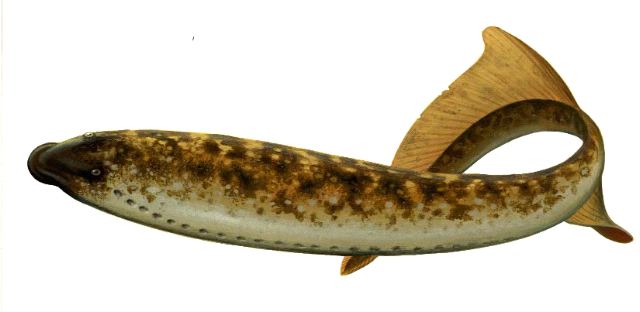Anaspids
Most jawless fish that thrived in the Silurian Period sported large bony shields on their head and trunk to protect them from predators.
 (24 kb) For this reason, the Greek root aspis, which means “shield”, is found in the names of some agnathan groups, such as the cephalaspids, arandaspis and galeaspids. The anaspids were an exception, however, and their name means “without a shield”.
(24 kb) For this reason, the Greek root aspis, which means “shield”, is found in the names of some agnathan groups, such as the cephalaspids, arandaspis and galeaspids. The anaspids were an exception, however, and their name means “without a shield”.
Anaspids were a common group of jawless fish in Silurian time. Specimens measure 10 to 15 cm long and have only been discovered in regions that were once part of Euramerica. Unlike other agnathans, whose bodies were often flat, anaspids had a narrower and more slender body, closer to that of a “typical” fish. Their caudal fin (their tail) was strongly hypocercal, meaning that the lower lobe pointed downward and was larger than the upper lobe. This feature represents the extension of the fish’s notochord (the main axial support of the body) into the tail’s lower lobe.
Anaspids had 6 to 15 gill openings on either side of their body behind their mouths, a tri-radiate spine behind this series of openings, and median scales running along their backs. Current phylogenetic reconstructions closely link anaspids and ostracoderms to the first jawed vertebrates – the gnathostomes.
Two Miguasha fish species, Endeiolepis and Euphanerops, were traditionally classified as anaspids based on their general appearance (long body and hypocercal tail). This would make them the only known anaspids to appear in the Devonian Period. They had up to 30 gill openings and did not posses bony scales or spines. These differences compared to other anaspids make their evolutionary position debatable. Are they really anaspids or do they form a distinct group? Certain features of Miguasha’s “anaspids” are very comparable to those of modern lampreys. Euphanerops, Endeiolepis and lampreys, for example, all share the same gill type, and the histological structure of the internal cartilaginous elements is surprisingly similar.
Recently discovered Euphanerops specimens with finely preserved details have revealed new anatomical differences, many of which remain enigmatic. For the time being, the question of the true affiliation of Miguasha’s “anaspids” is unresolved. This is a story whose ending must read “To be continued...”

 (24 kb) For this reason, the Greek root aspis, which means “shield”, is found in the names of some agnathan groups, such as the cephalaspids, arandaspis and galeaspids. The anaspids were an exception, however, and their name means “without a shield”.
(24 kb) For this reason, the Greek root aspis, which means “shield”, is found in the names of some agnathan groups, such as the cephalaspids, arandaspis and galeaspids. The anaspids were an exception, however, and their name means “without a shield”.Anaspids were a common group of jawless fish in Silurian time. Specimens measure 10 to 15 cm long and have only been discovered in regions that were once part of Euramerica. Unlike other agnathans, whose bodies were often flat, anaspids had a narrower and more slender body, closer to that of a “typical” fish. Their caudal fin (their tail) was strongly hypocercal, meaning that the lower lobe pointed downward and was larger than the upper lobe. This feature represents the extension of the fish’s notochord (the main axial support of the body) into the tail’s lower lobe.
Anaspids had 6 to 15 gill openings on either side of their body behind their mouths, a tri-radiate spine behind this series of openings, and median scales running along their backs. Current phylogenetic reconstructions closely link anaspids and ostracoderms to the first jawed vertebrates – the gnathostomes.
Two Miguasha fish species, Endeiolepis and Euphanerops, were traditionally classified as anaspids based on their general appearance (long body and hypocercal tail). This would make them the only known anaspids to appear in the Devonian Period. They had up to 30 gill openings and did not posses bony scales or spines. These differences compared to other anaspids make their evolutionary position debatable. Are they really anaspids or do they form a distinct group? Certain features of Miguasha’s “anaspids” are very comparable to those of modern lampreys. Euphanerops, Endeiolepis and lampreys, for example, all share the same gill type, and the histological structure of the internal cartilaginous elements is surprisingly similar.
Recently discovered Euphanerops specimens with finely preserved details have revealed new anatomical differences, many of which remain enigmatic. For the time being, the question of the true affiliation of Miguasha’s “anaspids” is unresolved. This is a story whose ending must read “To be continued...”
Site map | Feedback | Links | Sources | Credits
Anaspids
<< Jawless fish | Endeiolepis >>

Title: Euphanerops longaevus
Author: Illustration FROM François Miville-Deschênes
Sources: Parc national de Miguasha
Year: 1999
Description:
A specimen of Euphanerops with the impression of the long branchial basket visible on the ventral side of the animal. Also evident is the strongly downward-pointing axis of the tail (caudal fin).


